Discover 13 Types of Owls in Arizona (From Rarest to Most Common)
At least 13 different types of owls can be found in Arizona. They range in size from less than 6 inches in length to more than 25 inches. Some eat insects, some eat rabbits, and some even eat other owls. Most of the owls in Arizona are active at night, though some stay up all day, and others are most active at dusk and dawn. You might see owls in the desert, in the forest, in the mountains and canyons, or even in grasslands throughout the state. Read on to discover 13 types of owls in Arizona, listed roughly in order from the rarest to the most common.
Cactus Ferruginous Pygmy-owl (Glaucidium brasilianum cactorum)
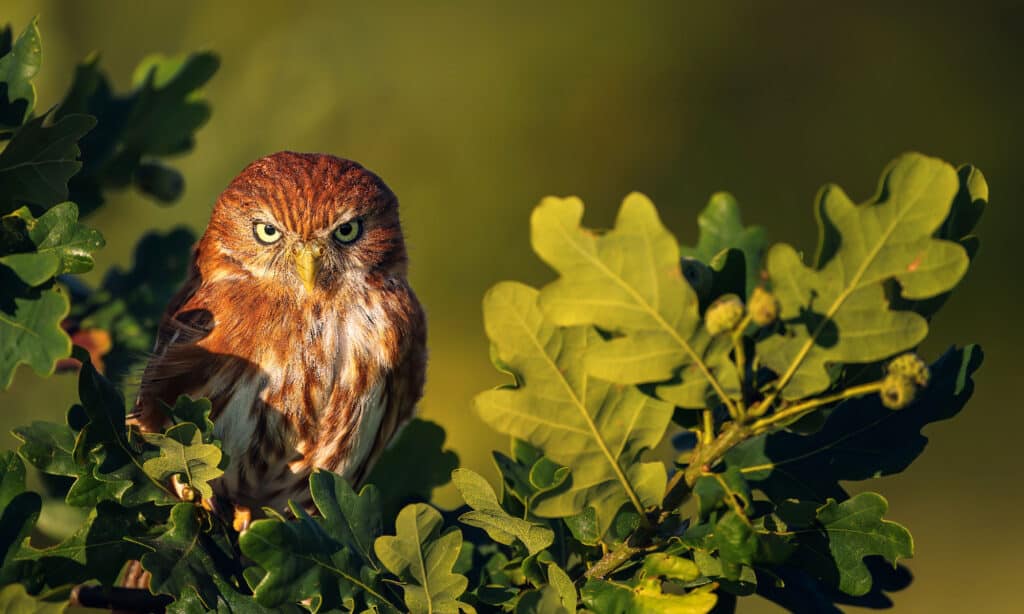
©Jan Stria/Shutterstock.com
The Cactus Ferruginous Pygmy-owl is a subspecies of Ferruginous Pygmy-owl. This small owl measures only about 5.5 to 7.1 inches in length with a wingspan of approximately 11,8 inches. Though typically rust colored, their plumage can vary to gray. This particular subspecies lives in southeastern Arizona, around the Tucson area, along with far southern Texas, south of Laredo, and parts of northern Mexico. The U.S. Fish and Wildlife Service listed the Cactus Ferruginous Pygmy-owl as a threatened subspecies in 2023. It has an estimated population of less than 1,000. This subspecies nests in tree cavities and in columnar cactus species. Ferruginous Pygmy-owls stay active through the daytime, setting them apart from most other species.
Mexican Spotted Owl (Strix occidentalis lucida)
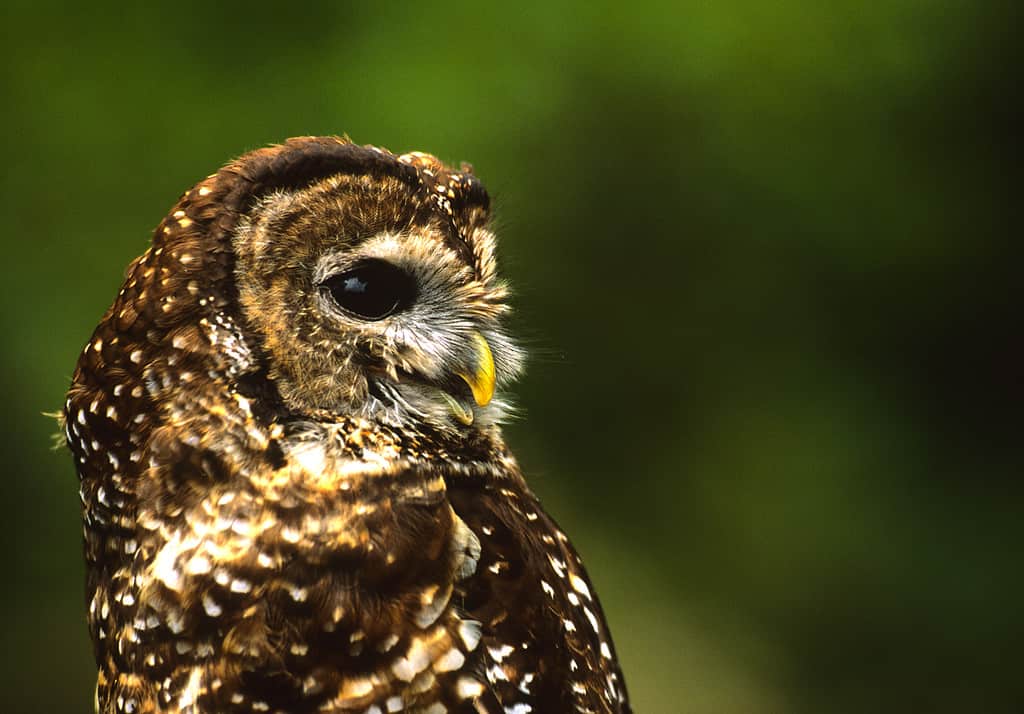
©Images in the Wild/iStock via Getty Images
The U.S. Fish and Wildlife Service listed the Mexican Spotted Owl as threatened subspecies in 1993. Although no one knows the exact population, biologists estimate that somewhere between 1,000 and 10,000 of these owls exist in the wild. Its population is decreasing, mainly due to wildfires. The U.S. Fish and Wildlife Service designated critical habitat for the owl within Arizona, Utah, Colorado, and New Mexico in 2004. The Mexican Spotted Owl is geographically and genetically isolated from the other two subspecies in the United States, the Northern Spotted Owl and the California Spotted Owl. The Mexican Spotted Owl resides only in small areas, mostly in mountains or canyons in mixed coniferous forests. This mottled brown owl grows to about 16 to 19 inches, and has a wingspan up to 45 inches.
Flammulated Owl (Psiloscops flammeolus)
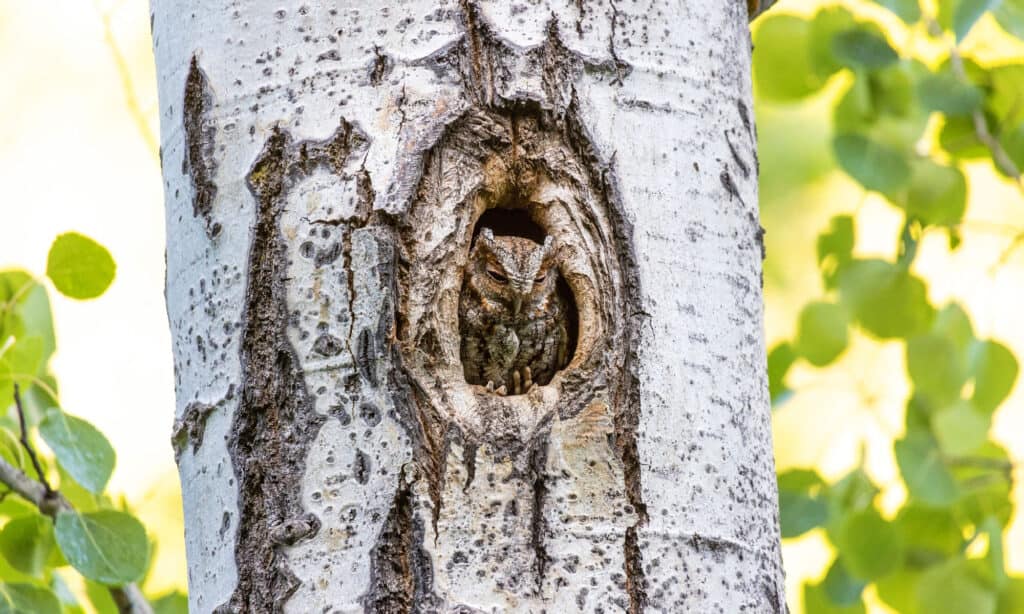
©iStock.com/Devonyu
Although the Flammulated Owl has an estimated population of just 12,000 individuals, according to estimates from Partners in Flight, the IUCN Red List of Threatened Species lists the bird as a species of least concern. This tiny owl with a flame-like pattern measures about 6 inches in length and has a wingspan of about 14 inches. In Arizona, it breeds primarily in forests rich in ponderosa pines in the central, northeast, and southeast parts of the state. Flammulated Owls generally migrate south for the winter.
Elf Owl (Micrathene whitneyi)
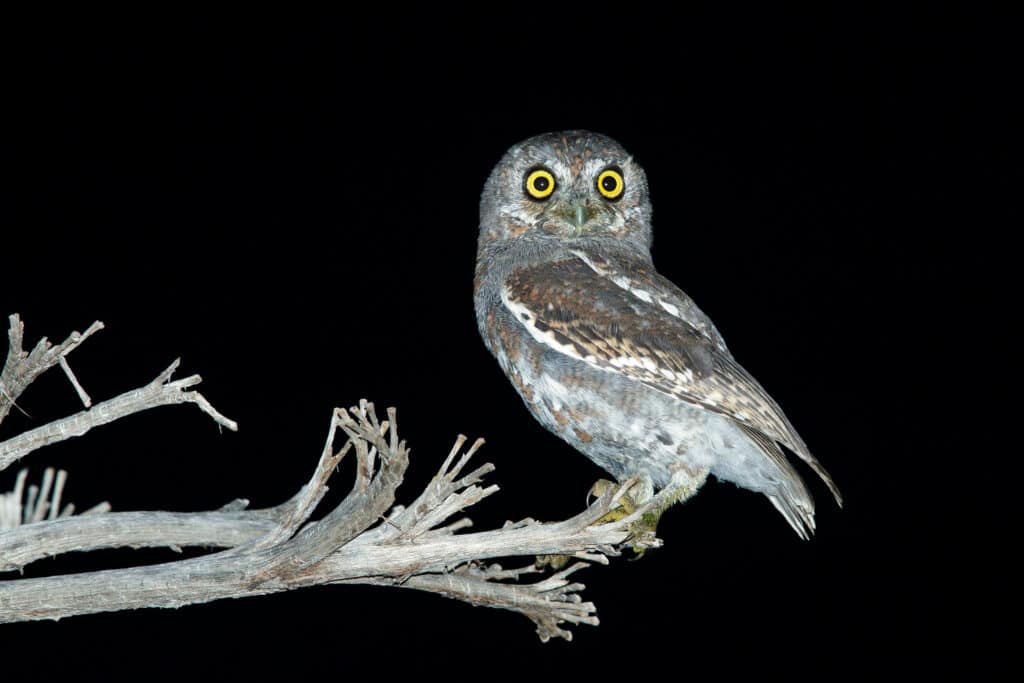
©Agami Photo Agency/Shutterstock.com
The smallest of the owls found in Arizona, the Elf Owl, reaches lengths between 4.9 and 5.7 inches. They measure roughly the same size as a sparrow, and they have a wingspan just over 10 inches. The tiny Elf Owl nests in abandoned cavities in large cacti and hardwood trees. It breeds in the southern half of Arizona, migrating south for the winter. The IUCN Red List of Threatened Species lists the Elf Owl as a species of least concern with an estimated population of 72,000. Numbers have decreased in recent years due to habitat destruction.
Whiskered Screech-Owl (Megascops trichopsis)
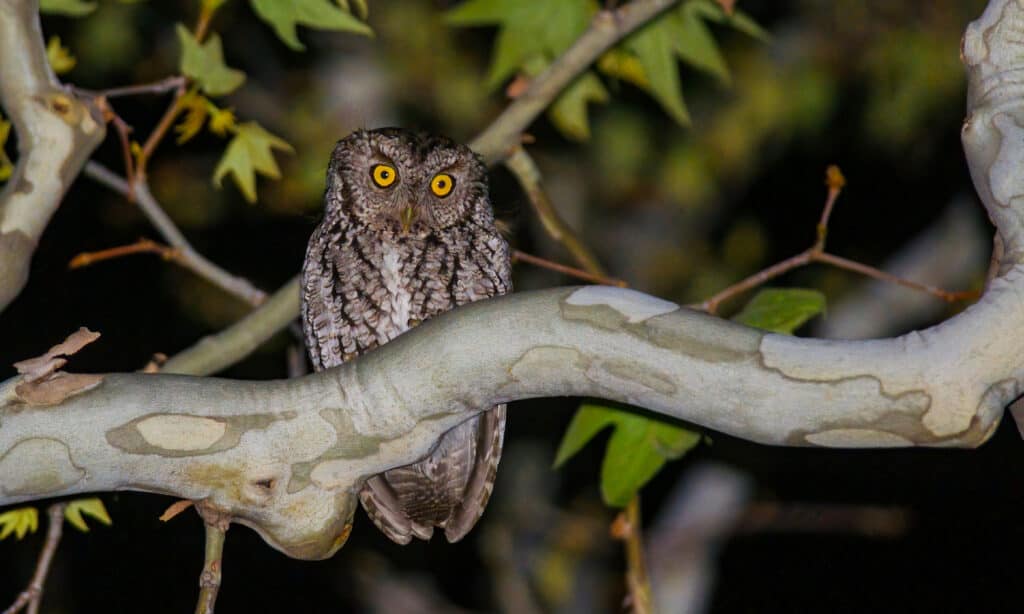
©Amanda Guercio/Shutterstock.com
Although the Whiskered Screech-owl has an estimated population of about 200,000, only around five percent of those individuals live in the United States. These reside in far southeastern Arizona, south and east of Tucson, and southwestern New Mexico. That makes the Whiskered Screech-owl one of the rarest owls in Arizona with some of the most limited habitat in the state. This small owl measures 6.5 to 7.9 inches in length with a wingspan up to 19.7 inches. Their plumage varies from brown to dark gray.
Northern Pygmy Owl (Glaucidium californicum)
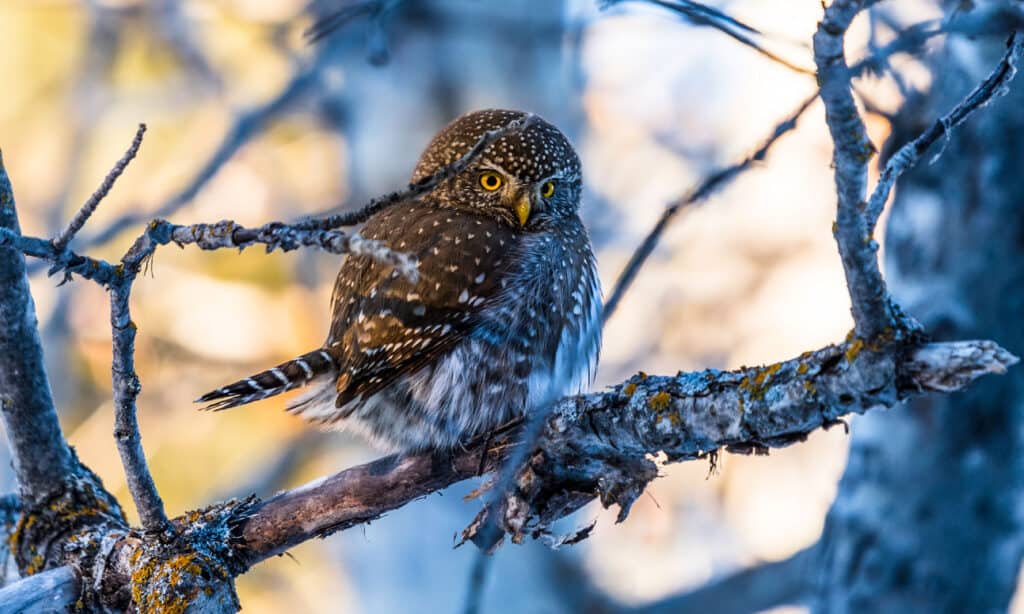
©Jordan Feeg/Shutterstock.com
Different sources estimate the population of the Northern Pygmy-owl between 80,000 and 180,000 individuals. They range from northwestern Canada, through the western United States mostly in the mountainous regions and the coast, to far northern Mexico. In Arizona, the Northern Pygmy-owl resides primarily in the forests in the eastern half of the state. This species is another that is active during the daytime. This small owl with a yellow beak and speckled head grows to be about 6.3 to 7.1 inches long with a wingspan up to 16 inches.
Short-eared Owl (Asio flammeus)

©iStock.com/Devonyu
Although the IUCN Red List of Threatened Species estimates the population of the Short-eared Owl at 1.2 million to 2.1 million worldwide, that population is distributed widely. This species ranges over the Americas, Asia, Europe, and part of Africa. In Arizona, the Short-eared Owl has only a non-breeding presence. They migrate south to the area in the winter. The species has more of a rare presence in the state than their large overall population might suggest. Short-eared owls have very short tufts on their heads, and large yellow eyes with prominent dark liner. They reach lengths of 13.4 to 16.9 inches with an impressive wingspan of up to 43 inches. This species may roost in communal groups in the winter near open areas where they can hunt.
Western Screech-Owl (Megascops kennicottii)

©Steve Bruckmann/Shutterstock.com
The Western Screech-owl is a year-round resident throughout the state of Arizona. With an estimated population of around 180,000, this species ranges from Alaska south along the coast of Canada, throughout much of the western United States from the Rocky Mountains to the coast, and through much of Mexico. Western Screech-owls vary from brown to dark gray, all with streaked underparts. They resemble Eastern Screech-owls and were thought to be the same for some time, but they are now recognized as a unique species. This owl lives mainly in the forested regions. It grows to lengths of about 7.5 to 9.8 inches and has a wingspan that may reach 24 inches.
Long-eared Owl (Asio otus)
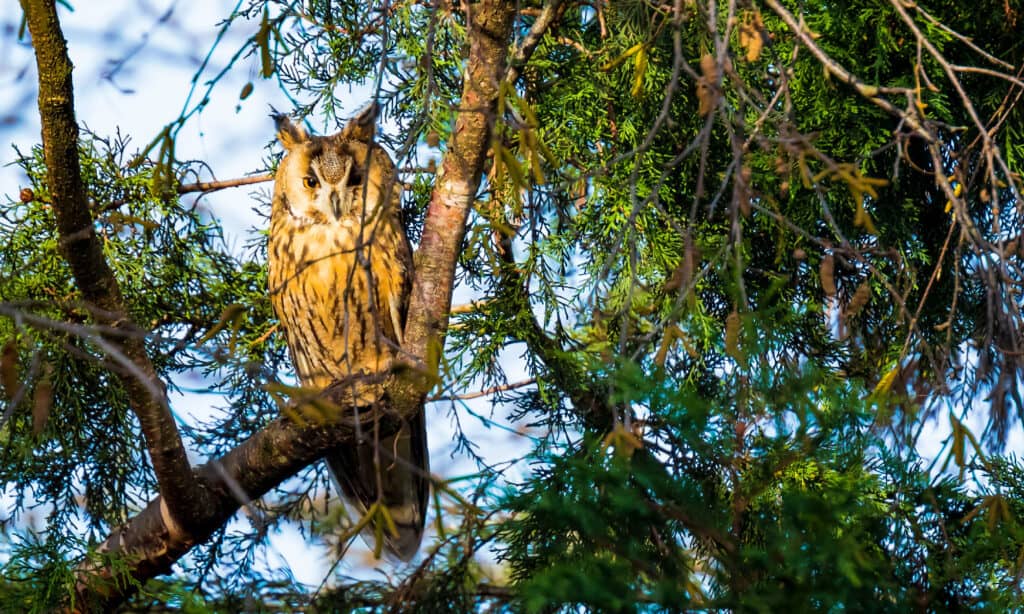
©SanderMeertinsPhotography/Shutterstock.com
The Long-eared Owl, also known as the Northern Long-eared Owl, has an immense range, covering much of North America, as well as Europe, Asia, and far northern Africa. The IUCN Red List of Threatened Species estimates this species to have a population between 2.2 million and 3.7 million individuals. The Long-eared Owl is a year-round resident throughout most of the state of Arizona, except the far southwestern corner, where it winters, but does not breed. This larger owl reaches lengths between 12.2 to 15.7 inches and has a wingspan up to 40 inches. Though the Long-eared Owl typically prefers forested areas, some have adapted well to life in the desert.
Northern Saw-whet Owl (Aegolius acadicus)
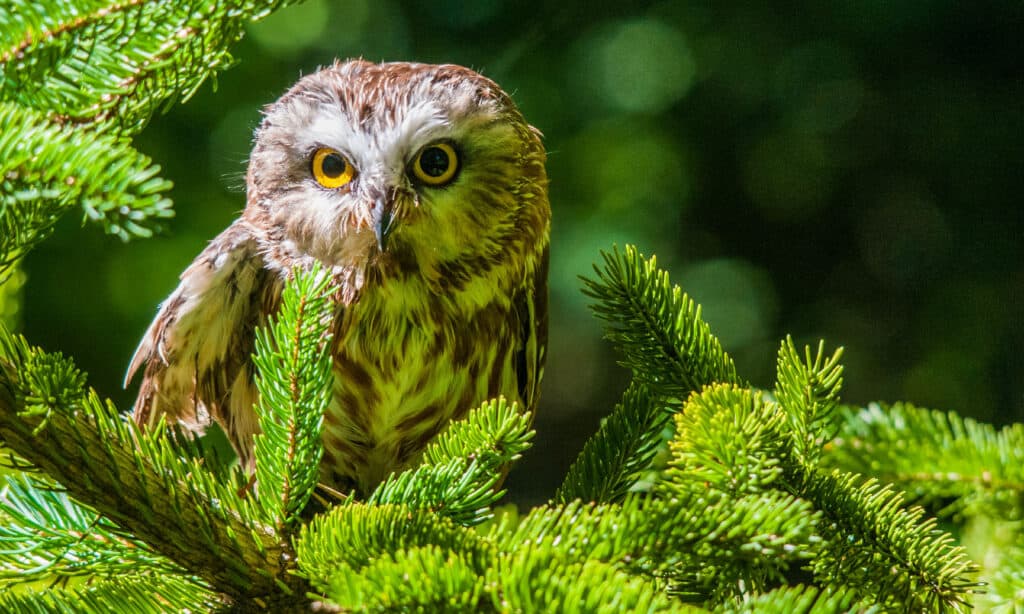
©iStock.com/bookguy
The Northern Saw-whet Owl ranges over the entire United States, with the exception of far southern Texas and south Florida. They also range over much of Canada, north to Alaska, and isolated populations live in Mexico. The IUCN Red List of Threatened Species estimates the population of the Northern Saw-Whet Owl as around 2,000,000 individuals. This owl maintains a year-round presence in north and east Arizona, and a winter presence in the rest of the state, except for the far southern border. Northern Saw-whet Owls live mostly in thickets and can be difficult to spot. These light-faced owls with yellow eyes range in size from 6.7 to 8.7 inches, and have a wingspan up to 22 inches.
Burrowing Owl (Athene cunicularia)
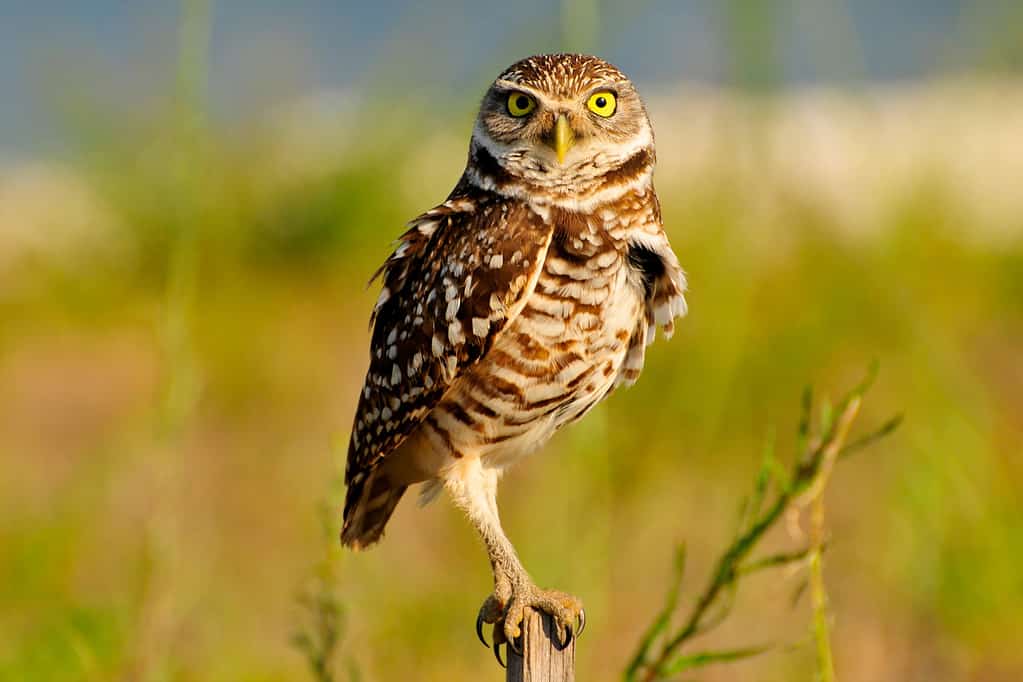
©Joliegordon/iStock via Getty Images
Burrowing Owls have an extremely large population. Partners in Flight estimates the population of the species at approximately 18,000,000. Their extensive range covers the western United States into southwestern Canada, part of Florida, most of Mexico, the Caribbean, Central America and much of South America. In Arizona, Burrowing Owls maintain a resident population in the southern part of the state, while a breeding population migrates into the northern part of state in warmer months. Unlike other owls in Arizona, the Burrowing Owl makes its nests in burrows underground. This species averages about 7.5 to 11 inches in length with a wingspan up to 24 inches. It has brown plumage with barring and white eyebrows over piercing yellow eyes that give it a stern look.
Barn Owl (Tyto alba)

©iStock.com/mzphoto11
Barn Owls have the widest distribution of any type of owl in the world with an estimated population, according to the IUCN Red List of Threatened Species, of more than 4 million. In Arizona, this owl is a permanent resident in all but the northeastern corner of the state. The Barn Owl has an easily recognized heart-shaped face. It reaches lengths of 11.4 to 17.3 inches with a wingspan up to 41 inches. It lives in all sorts of habitats across the state. Barn Owls nest in natural tree cavities, in nest boxes, or in artificial structures. They have adapted well to living near humans, and farmers often encourage them by providing suitable nest boxes in exchange for free rodent control.
Great Horned Owl (Bubo virginianus)

©kojihirano/iStock via Getty Images
The largest owl in Arizona, the Great Horned Owl, is probably also the most common. With an estimated population of 5.7 million, according to Partners in Flight, the Great Horned Owl lives only in the Americas. This adaptable owl makes use of multiple types of habitats in Arizona. It lives in forests, usually near open grasslands or farms. It also lives in the desert, canyon, and mountain regions. Great Horned Owls grow to lengths of 16.9 to 25.2 inches and have a massive wingspan of up to 60 inches. This owl has a striped, brown appearance and large tufts on its head. It has large eyes and huge talons. The Great Horned Owl is one of the most adept nocturnal hunters in the world, consuming large numbers of rodents and other small animals. Unfortunately pesticides moving through the food chain have hurt this species and caused its population to decline.









